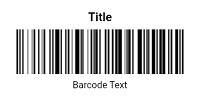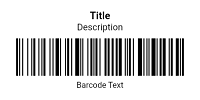Pharmacode, also known as the Plessey or Pharmaceutical Code, is a barcode symbology primarily used in the pharmaceutical and healthcare industries. It is designed for encoding numeric data, particularly in applications where the efficient tracking and identification of pharmaceutical products and medical supplies are crucial.
Pharmacode was introduced in the 1970s as a solution for the pharmaceutical industry’s need for a reliable and standardized method of encoding numeric data. Developed by the Plessey Company, the symbology aimed to streamline the tracking and management of pharmaceutical products, enhancing accuracy in labeling and inventory processes.
Technical Specifications
Pharmacode barcodes encode numeric data in a way that facilitates easy scanning and data entry. The symbology uses a sequence of bars and spaces to represent each digit, with a specific structure tailored for pharmaceutical applications.
The key features of Pharmacode include:
- Numeric Encoding: Pharmacode is designed to encode digits, typically up to 12 numeric characters, providing a flexible range for product identification and tracking.
- Symbology Structure: The barcode consists of a series of bars and spaces, where each combination represents a specific digit. The barcode's design allows for high-density data encoding, making it efficient for use in various applications.
- Check Digit: Pharmacode includes a check digit for error detection, ensuring the accuracy of the encoded data. The check digit is calculated based on the other digits in the barcode to verify data integrity during scanning.
Check Digit Calculation
The check digit in a Pharmacode barcode is calculated using a modulo 10 algorithm. The process involves:
- Summing the numeric values of the digits in the barcode.
- Calculating the remainder when this sum is divided by 10.
- Subtracting the remainder from 10 to obtain the check digit. If the remainder is 0, the check digit is 0.
This method helps ensure that the encoded data is accurately represented and reduces the likelihood of errors during scanning.
Advantages and Disadvantages
The Pharmacode barcode offers several benefits, including its high-density encoding, which allows for the efficient use of space on packaging. Its focus on numeric data makes it suitable for applications where only numerical information is required, and its check digit enhances data accuracy and reliability.
However, Pharmacode has limitations. Its restriction to numeric data can be a drawback in applications requiring alphanumeric encoding. Additionally, the barcode's fixed length and specific design may not be as flexible as other symbologies like Code 128, which supports a broader range of characters and offers more compact encoding.
Pharmacode Applications
Pharmacode is predominantly used in the pharmaceutical industry for various purposes:
- Product Tracking: Enables the efficient tracking of pharmaceutical products through the supply chain, from manufacturing to distribution and retail.
- Inventory Management: Assists in managing inventory by providing a reliable method for encoding and retrieving product information.
- Labeling: Used on packaging and labels to ensure accurate product identification and to comply with industry regulations.
Comparison with Other Barcode Symbologies
Compared to other barcodes such as UPC and EAN-13, Pharmacode is more specialized, focusing on numeric encoding for the pharmaceutical sector. While UPC and EAN-13 are widely used for retail and have broader applications, Pharmacode’s high-density encoding is tailored for industries needing efficient numeric data management. Unlike Code 128, which supports a wide range of characters and has a more complex structure, Pharmacode is simpler and optimized for numeric data in specific applications.
Pharmacode is a specialized barcode symbology designed to meet the needs of the pharmaceutical and healthcare industries. Its ability to encode numeric data with high density and its inclusion of a check digit make it a valuable tool for product tracking, inventory management, and labeling. While its limitations to numeric data and fixed design may restrict its use in some applications, its efficiency and accuracy have established it as an important standard in the pharmaceutical sector.


